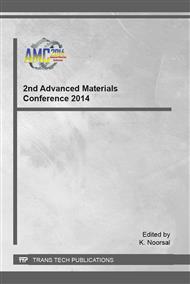p.505
p.510
p.515
p.523
p.527
p.532
p.537
p.542
p.547
Effect of Single and Bimetallic Ni, V and Mn Transition Metal Ion Doping on the Properties of Anatase/Brookite TiO2 Photocatalyst
Abstract:
Titania with a mixture of anatase, rutile and brookite nanostructures have gained much attention lately due to their high photocatalytic activity. Pure titania (TiO2) with a mixture of anatase, rutile, brookite phase were synthesized by hydrothermal treatment using titanium isopropoxide (TTIP) and 1.0 M of urea. The titania were doped with 1wt% of single transition metal nickel (Ni), vanadium (V) and manganese (Mn) and 1 wt% bimetallic transition metal of Ni-V and Ni-Mn, respectively. Pure titania shows higher, 94 % degradation of ibuprofen (Ibp) as the presence of brookite phase in the structure. The band gap energy of titania was obtained using the Kubelka-Munk reflectance function decreased as doping a transition metallic dopant where the energy order are V<MN<Ni, respectively. Bimetallic dopant V and Mn contribute higher photocatalytic activities as decreasing band gap energy of Ni ion doping.
Info:
Periodical:
Pages:
527-531
Citation:
Online since:
January 2016
Keywords:
Price:
Сopyright:
© 2016 Trans Tech Publications Ltd. All Rights Reserved
Share:
Citation:


